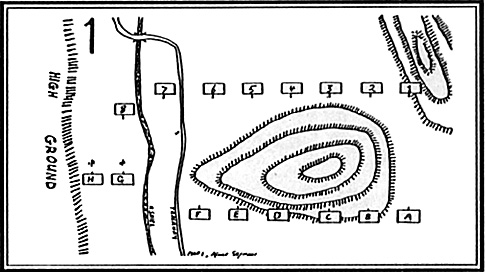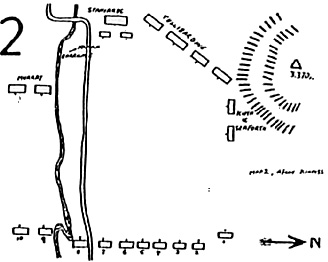England had gone to war with Spain in December 1718, which gave the exiled Jacobites the chance of gaining support for yet another attempt to gain a throne for James III. The previous attempt in 1715 had failed fairly convincingly, having cost its supporters 12 million pounds.
The effective ruler of Spain was Cardinal Alberoni, and in furtherance of Spanish war aims he commissioned the Duke of Ormonde to organise an expedition. This consisted of 5,000 men (with 15,000 sets of arms for recruits) and 29 ships, which sailed from Cadiz on 27th March. A smaller expedition was to set out from San Sebastian for a different part of Scotland with the Jacobites in exile in France: Lord Kieth, the Earl Marischal; James Kieth, his brother, the Marquess of Tullibardine; Lord George Murray; the Earl of Scaforth; John Cameron of Lochiel; and Macdonald of Keppoch.
The main fleet ran into bad weather and was forced back to Spain. The smaller fleet, carrying the above mentioned peerage of Scotland, along with 307 Spanish soldiers and a supply of arms and ammunition, after a long and eventful voyage around the north of Scotland rendezvoued off Eilean Donan Castle at Loch Alsh on 2nd April, and by the 17th had unloaded its cargo. There followed several weeks of inactivity as the leadership argued over who was going to command. Eventualy Tullibardine took control of the land forces and the Earl Marischal kept control of the fleet, which was sent away to prevent Tullibardinc re-embarking the troops and going home.
An English frigate squadron attacked Eilean Donan and destroyed it, but not before a supply of munitions had been removed. Some of the Clans were persuaded to join the rising (they still remembered the fiasco of Sheriffmuir in 1715) And the forces encamped at the pass of Glenshiel. Here they were found on 9th June by a Government column commanded by General Weightman, who had commanded the Government's regular troops at Sheriffmuir.
The Jacobites were deployed according to (1) as in map 1, according to (2) as in map 2. (1) notes that 'sangars' were constructed by the Jacobites, (2) gives them 'barricades' on his map. The Jacobite right wing was engaged at noon and its skirmish line pushed back, but the main battle did not develop until 5pm. The mortars were used to drive Murray's forces back, and then turned on the Spanish (to little effect due to the extreme range). The Mackays had passed around the flank of Scaforth's men and Scaforth himself was wounded in the fighting. The Jacobite line was rolled up from its left and before nightfall was pouring away down the pass. It was noted that this was one of the few (if not the only) engagements where Highlanders did not charge or fight hand to hand. Their enthusiasm was so low that the firefight was enough of an excuse to go home.
The Jacobites lost less than ten casualties, although (other than the Spanish, who surrendered after the battle) none were found by the Government forces, who themselves lost 21 killed and about 40 wounded.
Sources:
1 Battles in Britain, William Seymour.
2 Discovering Battlefields of Scotland, John Kinross.
Glenshiel: The Key
| Government Forces | Jacobite Forces | ||
|---|---|---|---|
| Map 1 | Map 2 | Govt Unit | Map 1 |
| A | 10 | Mackays (from Sutherland) | 1 - Seaforth |
| B | 1,2,3 | Major Miliburne's Grenadiers | 2 - Mackintosh. |
| C | 4 | 11th Foot (Montague) | 3 - Campbell |
| D | 5 | 15th Foot (Harrison) | 4 - Mackenzie |
| E | 6 | Dutch (Huffel) | 5 - Rob Roy McGreggor |
| F | 7 | Dragoons (Robertson's) | 6 - Lochiel |
| G | 8 | Clayton's | 7 - Spanish |
| H | 9 | Munro's Highlanders | 8 - Murray |
| Government: 850 Foot, 120 Dragoons 136 Highlanders & 6 mortars | Jacobites: 1600 Hig hlanders & 250 Spanish | ||


Back to 18th Century Military Notes & Queries No. 1 Table of Contents
Back to 18th Century Military Notes & Queries List of Issues
Back to Master Magazine List
© Copyright 1989 by Partizan Press
This article appears in MagWeb (Magazine Web) on the Internet World Wide Web.
Other military history articles and gaming articles are available at http://www.magweb.com